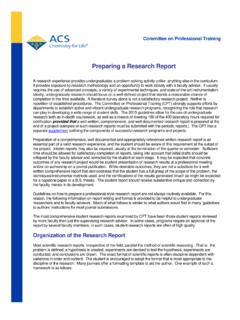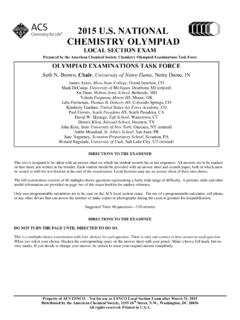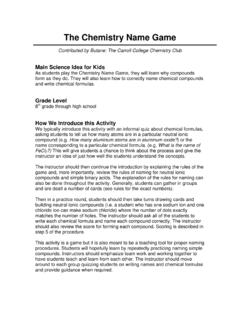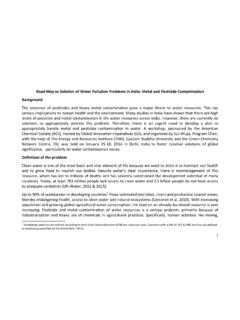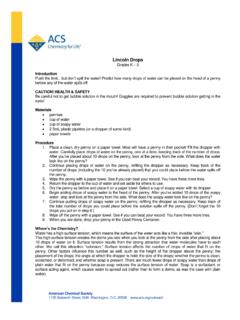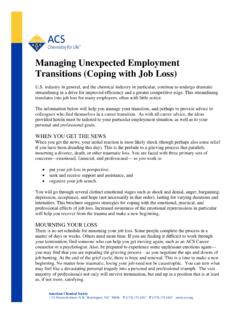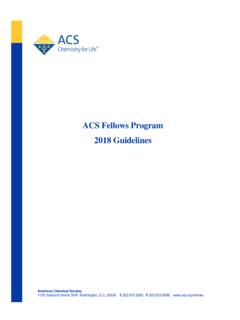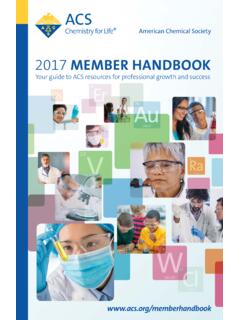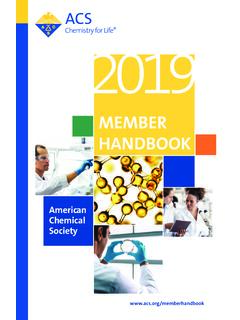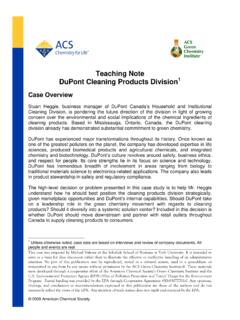Transcription of Greener Solvents - American Chemical Society
1 Greener Solvents Dr. Tamer Andrea Queen s University GreenCentre Canada Typical stage of university technologies: Bench-test proof of utility Applications speculative and unproven Incomplete material characterization Grams of sample Manufacturing feasibility not studied What Industry wants: Demonstrated scale-up Optimization Field-test proof of utility Kilograms of sample The Commercialization Gap Process for Technology Disclosures Stage 1: Quick Screening Stage 2: Technology Assessment Stage 3: Technology Development Output: analysis of commercialization potential Output: technology returned without assessment Output: licensable technology; 75/25 split $ $ Assessment indicates need for PoP funding GCC Option GCC exclusive license Green Solvents Dr. Philip Jessop Queen s University GOALS OF GREEN CHEMISTRY: REDUCE SOLVENT USE Mass utilization in fine Chemical production Solvent 80-90% Other 10-20% E factor = Mass of waste Mass of product Industry segment Product tonnage E factor Bulk chemicals 104 - 106 <1 - 5 Fine chemicals 103 - 104 5 - 50 Pharmaceuticals 10 - 103 25 - over 100 R.
2 Sheldon, CHEMTECH 1994, 38. PROBLEMS WITH CURRENTLY USED Solvents In the US in the early 1990 s: solvent production was 26 million tons of tracked chemicals, many of the top chemicals released or disposed of were Solvents (MeOH, toluene, xylene, CS2, MEK, CH2Cl2) Organic solvent hazards flammable (almost all except chlorinated Solvents ) carcinogenic (chlorinated Solvents and aromatics) high vapour pressure ( inhalation route) narcotic (ether, chloroform) toxic (MeOH, CS2) mutagens/teratogens (toluene) peroxides (ethers) smog formation OUTLINE the Impact of Solvents Properties Conventional Solvents Solvents DECREASING THE IMPACT OF Solvents the volume of solvent use higher concentrations use solvent for more than one step 2.
3 Make the Solvents Greener carefully chosen conventional Solvents new green Solvents Murphy s Law of Solvents The best solvent for any process step is bad for the subsequent step. AN IMAGINARY PROCESS Solving Murphy s Law of Solvents 1. A Compromise Solvent 2. A Switchable Solvent CAREFUL SELECTION OF A TRADITIONAL SOLVENT SWITCHABLE-POLARITY SOLVENT Nature (2005) 436, 1102 Ind Eng Chem Res (2008) 47, 539 CO2 N2 or Ar APPLICATION TO POLYSTYRENE SYNTHESIS mL styrene mL DBU/PrOH 45 mg initiator 75 C 6 h CO2 filter or centrifuge + Mn = 412,000 PDI = N2 DECREASING THE IMPACT OF Solvents the volume of solvent use higher concentrations use solvent for more than one step 2. Make the Solvents Greener carefully chosen conventional Solvents unconventional Solvents OUTLINE the Impact of Solvents Properties Conventional Solvents Solvents PROPERTIES OF CONCERN For green-ness boiling point / energy to distill flash point energy to distill cumulative energy demand the 10 factors For utility polarity basicity / hydrogen-bond accepting ability acidity / hydrogen-bond donating ability viscosity THE TOOLBOX ANALOGY KAMLET-TAFT SOLVATOCHROMIC PARAMETERS cyclohexane KAMLET-TAFT SOLVATOCHROMIC PARAMETERS (basicity) (acidity) * (polarity/polarizability) protic Solvents aprotic Solvents KAMLET-TAFT SOLVATOCHROMIC PARAMETERS protic Solvents aprotic Solvents (basicity) (acidity) * (polarity/polarizability)
4 Cyclohexane water NEt3 CHCl3 tBuOH HMPA toluene formamide 0 1 0 1 * High polarity Low polarity High basicity Low basicity cyclohexane, hexane, heptane Et2O dioxane THF EtOAc DMA DMF NMP NEt3 DMSO OP(OEt)3 PhNO2 PhCN pyridine toluene p-xylene anisole propylene carbonate sulfolane HMPA acetone MeCN MeNO2 CH2Cl2 CHCl3 NBu3 MEK CCl4 & Cl2C=CCl2 Cl2C=CClH PhCl PhBr EtO2 CEt BzNMe2 EtO2 CCl3 butyrolactone Me2py 4-Mepy ClC2H4Cl benzene quinoline tetramethyl-urea MeO2CH MeOAc EtO2 CPh MeOC2H4 OMe Pr2O SURVEY OF Solvents (APROTIC) Jessop, Green Chem (2012) 14, 1245 0 1 1 * High basicity Low basicity PhCH2OH tBuOH formamide iPrOH octanol butanol hexanol ethanol ethylene glycol acetic acid water glycerol hexanoic acid CF3CH2OH phenol methanol (CF3)2 CHOH High polarity Low polarity 1-propanol CF3CO2H SURVEY OF Solvents (PROTIC) Jessop, Green Chem (2012) 14, 1245 OUTLINE the Impact of Solvents Properties Conventional Solvents Solvents PFIZER SOLVENT SELECTION GUIDE WHICH SOLVENT IS Greener ?
5 General Comparison solvent impact solvent impact including manufacture energy to manufacture / cumulative energy demand Application-Specific Comparision ISO LCA solvent #1 solvent #2 ENVIRONMENTAL AND HEALTH RISKS Capello et al., Green Chem (2007) 9, 927 Alcohols Acetate esters Acids Acetonitrile Dioxane Formaldehyde ENERGY REQUIREMENT FOR MANUFACTURE 0 50 100 150 200 250 300 Ethanol Hexane Acetone Toluene DMF EtOAc THF MJ/kg Capello et al., Green Chem (2007) 9, 927 ENERGY REQUIREMENTS FOR A SOLVENT How is DMF made? How is hexane made? oil hexane distillation WHICH SOLVENT IS Greener ? General Comparison solvent impact solvent impact including manufacture energy to manufacture / cumulative energy demand Application-Specific Comparision ISO LCA solvent #1 solvent #2 Why would this give a different result?
6 PROPOSED NEW GREEN ORGANIC Solvents Aparicio, Green Chem. (2009) 11, 65 Horvath, Green Chem., 2008, 10, 238 ethyl lactate g-valerolactone 2-methyltetrahydrofuran cyclopentylmethylether Aycock, Org. Process Res. Dev. 2007, 11, 156 Watanabe, Org. Process Res. Dev. 2007, 11, 251 low toxicity, biodegradable, renewable low toxicity, biodegradable, renewable doesn t form peroxides, low solubility in water renewable 0 1 0 1 * High polarity Low polarity High basicity Low basicity heptane EtOAc propylene carbonate acetone MEK (EtO)2CO iPrOAc PEG PPG -valerolactone 2-MeTHF GREEN Solvents (APROTIC) Jessop, Green Chem (2012) 14, 1245 0 1 1 * High basicity Low basicity tBuOH iPrOH butanol ethanol ethyl lactate water glycerol methanol High polarity Low polarity 1-propanol GREEN Solvents (PROTIC) Jessop, Green Chem (2012)
7 14, 1245 OUTLINE the Impact of Solvents Properties Conventional Solvents Solvents UNCONVENTIONAL Solvents supercritical CO2 CO2-expanded liquid ionic liquid liquid polymer switchable solvent water IN WATER Why not water? Li, 1995 ~haoli/photo_gallery/archives/olympic/ SWITCHABLE WATER water & B water & [BHn][HCO3]n CO2 -CO2 low ionic strength low osmotic pressure good solvent for polar organics high ionic strength high osmotic pressure poor solvent for polar organics Mercer, Jessop, et al. ChemSusChem (2010) 3, 467 Mercer, Jessop, et al. Green Chem (2012) 14, 832 water, B, & product CO2 water, B, & product filter water & [BHn][HCO3]n product product -CO2 IONIC LIQUIDS NaCl, mp 801 C NaBF4, mp 384 C [PiBu3Me]O3SC6H4Me, mp < RT Nonvolatile Nonflammable Doesn t create smog No inhalation hazards BY GENERAL COMPARISON, ARE IONIC LIQUIDS GREEN?
8 Zhang, Env. Sci. Tech. (2008) 42, 1724 Jessop, Green Chem (2011) 13, 1391 Chemical STEPS IN SOLVENT SYNTHESIS Jessop, Green Chem (2011) 13, 1391 Chemical STEPS IN SOLVENT SYNTHESIS Jessop, Green Chem (2011) 13, 1391 LIQUID POLYMERS LIQUID POLYMERS ionic liquids liquid polymers Nile Red scale Heldebrant, Jessop et al. Green Chem (2006) SOME ORGANIC Solvents ARE VOLATILE Volatile Solvents flammability high insurance costs vapour losses smog formation inhalation hazards - toxic, - narcotic, - mutagenic, - carcinogenic Nonvolatile Solvents no flammability low insurance costs no vapour losses no smog formation no inhalation hazards SWITCHABLE-HYDROPHILICITY Solvents Green Chem (2010) 12, 809 Green Chem (2011) 13, 619 A REAL WORLD PROBLEM extract with solvent distill Green Chem (2010) 12, 809 hexane emissions to air in Canada (NPRI, 2007) SOY EXTRACTION WITHOUT DISTILLATION extract with solvent H2O CO2 -CO2 Green Chem (2010) 12, 809 Green Chem (2011)
9 13, 619 [ 51 52 using A SWITCHABLE-HYDROPHILICITY SOLVENT extract Add water & CO2 - CO2 oil sands OIL SANDS 53 OUTLINE the Impact of Solvents Properties Conventional Solvents Solvents Ionic Liquids Liquid Polymers Switchable Solvents Gas-Expanded Liquids Supercritical Fluids EXPANSION OF LIQUIDS BY CO2 CO2-expanded NEt3 (Jessop, 1996) Volumetric expansion of aprotic Solvents by CO2 at 40 C (Kordikowski, 1995) Characteristics: tunable polarity tunable solvent properties lowered melting point improved mass transfer rates improved solubility of reagent gases EFFECT OF SOLVENT CHOICE Expansion with CO2 increases in the order: water < ionic liquid liquid polymer < protic polar < aprotic polar < nonpolar Class Examples Volumetric change Properties that change Properties that don t change I Water Glycerol Very small Acidity Most II Hexane Methanol DMF Very large All None III Ionic liquids Liquid polymers Crude oil Moderate Viscosity Phase behaviour Polarity review paper: Jessop & Subramaniam, Chem.]
10 Rev. (2007) 107, 2666 VISCOSITY 0200400600800100012001400020406080100120 140160P, barViscosity, cpCrude oil Viscosity of CO2-expanded crude oil at 49 C Simon & Graue, J. Petrol. Technol. (1965) 102. CO2 CAN TRIGGER INSOLUBILITY AND IMMISCIBILITY Polar solids are precipitated from solution when the solvent is expanded with CO2 CO2 CO2 pressure Some miscible liquids become immiscible when expanded with CO2 Solvent A Solvent B P, bar water methanol 80 water 1-propanol 68 water acetic acid 75 water acetone 26 water THF <10 water 1,4-dioxane <28 water MeCN <19 OUTLINE the Impact of Solvents Properties Conventional Solvents Solvents Ionic Liquids Liquid Polymers Switchable Solvents Gas-Expanded Liquids Supercritical Fluids SUPERCRITICAL CO2 SOLUBILIZING POWER DEPENDS ON DENSITY Fe3(CO)12 CO2 CO2 AS A SOLVENT DuPont fluoropolymer plant, Natex CO2 decaffeination plant CO2 dry cleaning Prep SFC (Novasep)
